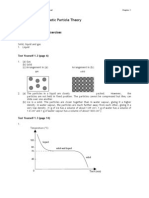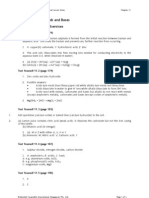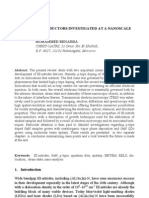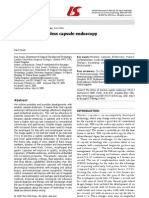Measurement: Test Yourself 1.2 (Page 5)
Measurement: Test Yourself 1.2 (Page 5)
Uploaded by
Vishwajeet UjhoodhaCopyright:
Available Formats
Measurement: Test Yourself 1.2 (Page 5)
Measurement: Test Yourself 1.2 (Page 5)
Uploaded by
Vishwajeet UjhoodhaOriginal Title
Copyright
Available Formats
Share this document
Did you find this document useful?
Is this content inappropriate?
Copyright:
Available Formats
Measurement: Test Yourself 1.2 (Page 5)
Measurement: Test Yourself 1.2 (Page 5)
Uploaded by
Vishwajeet UjhoodhaCopyright:
Available Formats
th
Physics Matters for GCE O Level (4 Edition): Full Solutions to Textbook Questions Chapter 1
Chapter 1 Measurement
Test Yourself 1.2 (page 5)
6
13 m = 13 10 m
5
= 1.3 10 m (in standard form)
Test Yourself 1.3 (page 11)
1. Zero reading = +0.02 mm
Diameter reading = 3.87 mm
Corrected diameter reading Dcorrected = 3.87 (+0.02) = 3.85 mm
2. Main scale reading = 2.5 cm
The 3rd vernier mark coincides with a marking on the main scale.
Vernier scale reading = 0.03 cm
Reading of diameter = 2.5 + 0.03 = 2.53 cm
3. The strip of mirror helps you to check that the image of the needle coincides with the needle when
taking a reading. This ensures that your eyes are positioned directly above the needle. This helps
to reduce parallax error.
Test Yourself 1.4 (page 15)
1. Moving from A to C to B covers only three-quarters of an oscillation. Hence,
3
T=3s
4
4
T=3s
3
=4s
2. At the beginning of the week (Monday), record the time at which you board the bus and the time
at which you alight the bus to go to school. The difference between the two times is the time
taken for the bus to travel from your home to school. Record these times every day over the
course of the week (until Friday). Calculate the average time taken to travel from your home to
school over the five days.
3. Start the swing in a to-and-fro motion. When the motion is steady, start the stopwatch when the
swing is at one end of its motion. Stop the stopwatch after 20 oscillations. Record the time as t1.
Repeat this for another reading t2.
t1 + t2
Calculate average t = .
2
t
The period T of the swing is given by T = .
20
2013 Marshall Cavendish International (Singapore) Private Limited
1.1
th
Physics Matters for GCE O Level (4 Edition): Full Solutions to Textbook Questions Chapter 1
Get It Right (page 16)
(a) True
(b) False
The SI units for mass, length, time, temperature, current and amount of substance are the
kilogram, metre, second, kelvin, ampere and mole respectively.
(c) True
(d) True
(e) True
(f) True
(g) False
The period of a pendulum calculated from the time taken for multiple oscillations is more
accurate than measuring the time taken for one oscillation.
Lets Review (pages 1617)
Section A: Multiple-Choice Questions
1. B
Since the distance to be measured is more than half a metre, the half-metre rule and the vernier
calipers should not be used. We can use either the metre rule or the measuring tape. Both
instruments have an accuracy of 0.001 m. However, measuring tapes are usually used to
measure lengths of several metres, and curved surfaces. Therefore, the best answer is a metre
rule.
2. B
Zero error (reading when vernier calipers is closed) = +0.5 mm
Reading when steel ball bearing is being measured = 15 + 0.5 = 15.5 mm
Diameter of steel ball bearing = 15.5 (+0.5) = 15.0 mm = 1.50 cm
3. B
Zero error (reading when micrometer screw gauge is closed) = +0.06 mm
Reading when ball bearing was measured = 1.5 + 0.48 = 1.98 mm
Diameter of ball bearing = 1.98 (+0.06) = 1.92 mm
Section B: Structured Questions
1. (a) Physical quantity: Length
Numerical magnitude: Five
Unit: Metre
(b) Physical quantity: Time
Numerical magnitude: Two
Unit: Second
(c) Physical quantity: Mass
Numerical magnitude: One thousand
Unit: Kilogram
2. (b)
3
(c) 10
(d) c
4
(e) 10
(f) M
2013 Marshall Cavendish International (Singapore) Private Limited
1.2
th
Physics Matters for GCE O Level (4 Edition): Full Solutions to Textbook Questions Chapter 1
3. Length to be measured Suitable instrument Precision
Several metres Tape measure 1 mm or 0.1 cm
Between one metre and several metres Tape measure 1 mm or 0.1 cm
Between 1 cm and 15 cm Vernier calipers 0.1 mm or 0.01 cm
0.01 cm Micrometer screw gauge 0.01 mm or 0.001 cm
Between 0.001 cm and 0.01 cm Micrometer screw gauge 0.01 mm or 0.001 cm
4. (a) Reading shown = 12.5 mm + 0.14 mm = 12.64 mm
(b) Use the micrometer screw gauge to take several diameter measurements (at various
points) along the wire. Take the average value of all the measurements to determine the
diameter of the wire.
5. (a) Reading = 20 mm + 0.5 mm = 20.5 mm
Width w = 2.05 cm
(b) Instrument Precision
Vernier calipers 0.01 cm
Metre rule 0.1 cm
Micrometer screw gauge 0.001 cm
(c) This method is inaccurate because the width of the slide may not be uniform. A more
accurate measurement can be obtained by measuring the width w of the slide at several
positions, using the vernier calipers to gently grip the slide perpendicularly as shown below
w1 + w2 + w3
and calculating the average width using this formula: w = . Futhermore, the
3
vernier calipers should be checked for zero error before the measurements are made. If
there is zero error, the readings will need to be corrected accordingly.
w1
glass slide w2
w3
Section C: Free-Response Question
1. (a)
Length of thread, l/m 0.35 0.65 1.00 1.45 1.95
Time for 20 oscillations, t/s 24.1 32.4 40.1 47.5 56.3
Time for 1 oscillation, T/s 1.21 1.62 2.01 2.38 2.82
2 2
T /s 1.46 2.62 4.04 5.66 7.95
2
Plot a graph of T against l.
2013 Marshall Cavendish International (Singapore) Private Limited
1.3
th
Physics Matters for GCE O Level (4 Edition): Full Solutions to Textbook Questions Chapter 1
(1.75,7.0)
(0.25,1.0)
7.0 1.0 6.0
Gradient of graph = = = 4.0
1.75 0.25 1.50
2
4
4.0 =
g
2
g = 9.9 m s
2013 Marshall Cavendish International (Singapore) Private Limited
1.4
th
Physics Matters for GCE O Level (4 Edition): Full Solutions to Textbook Questions Chapter 1
Physics Today (page 18)
1. The field of nanotechnology is relatively new and the effects of the interaction of nanoparticles
(including nanorobots) with the human body are not certain. Research has shown that elements in
the nanoscale may interact differently with the environment, as compared to their larger
counterparts. For example, fullerenes, nanoparticles of carbon that possess great potential in the
medical field due to their unique properties, may pose a different threat to the human body from
their larger scale counterpart, graphite. In fact, research results point towards fullerenes having the
same level of toxicity to humans as asbestos.
Other than that, the nanorobots could malfunction in the human body, leading to the possible loss
of control of the nanorobots. The potential harm of these robots to the human body is
unpredictable.
Web references:
http://www.futureforall.org/nanotechnology/risks.htm
http://en.wikipedia.org/wiki/Fullerene
http://www.crnano.org/dangers.htm
2. The robots need to be small enough to travel through blood vessels and cells to reach the targeted
cancer cells. In order to anchor onto the cancer cells, the robots also need to be smaller than the
cells.
Average diameter of blood capillary (the smallest blood vessel in the body): 7 m
Typical cell size: 10 m
2013 Marshall Cavendish International (Singapore) Private Limited
1.5
You might also like
- Chemistry Matters Ch01 Textbk ANSDocument3 pagesChemistry Matters Ch01 Textbk ANSZeneon86% (28)
- PM TB Solutions C06Document7 pagesPM TB Solutions C06Vishwajeet Ujhoodha88% (8)
- Precision Rifle BIBLE Vol 1Document132 pagesPrecision Rifle BIBLE Vol 1Marco Tulio100% (5)
- PM TB Solutions C02Document10 pagesPM TB Solutions C02Vishwajeet Ujhoodha86% (14)
- The Mole: Test Yourself 9.1 and 9.2 (Page 139)Document8 pagesThe Mole: Test Yourself 9.1 and 9.2 (Page 139)Abdul moiz Waheed82% (11)
- Chemistry Matters Textbook Answers Chapter 3Document3 pagesChemistry Matters Textbook Answers Chapter 3MahamIsmail93% (15)
- Chemistry Matters Ch11 Textbk ANSDocument3 pagesChemistry Matters Ch11 Textbk ANSZeneon82% (17)
- Chemistry Matters Ch16 Textbk ANSDocument2 pagesChemistry Matters Ch16 Textbk ANSZeneon63% (8)
- Respiration in Humans: Test Yourself 10.1 (Page 197)Document4 pagesRespiration in Humans: Test Yourself 10.1 (Page 197)lee67% (3)
- PM TB Solutions C01Document5 pagesPM TB Solutions C01Vishwajeet Ujhoodha100% (2)
- PM TB Solutions C05Document6 pagesPM TB Solutions C05Vishwajeet Ujhoodha82% (11)
- Practical Electricity: Test Yourself 19.1 (Page 365)Document5 pagesPractical Electricity: Test Yourself 19.1 (Page 365)Jack Kowman67% (6)
- PM TB Solutions C08Document4 pagesPM TB Solutions C08Vishwajeet Ujhoodha80% (5)
- This Study Resource Was: Current ElectricityDocument6 pagesThis Study Resource Was: Current ElectricityAbdul moiz Waheed100% (3)
- Electromagnetic Induction: Test Yourself 22.1 (Page 430)Document7 pagesElectromagnetic Induction: Test Yourself 22.1 (Page 430)Jack KowmanNo ratings yet
- Chemistry Matters Ch04 Textbk ANSDocument2 pagesChemistry Matters Ch04 Textbk ANSZeneon67% (21)
- CM TB Solutions C01Document3 pagesCM TB Solutions C01MahamIsmail86% (7)
- Chemistry Matters Ch06 Textbk ANSDocument2 pagesChemistry Matters Ch06 Textbk ANSZeneon80% (15)
- An Introduction To Organic Chemistry: Test Yourself 21.1 (Page 414)Document3 pagesAn Introduction To Organic Chemistry: Test Yourself 21.1 (Page 414)Jack Kowman75% (8)
- Alkanes and Alkenes: Test Yourself 22.1 (Page 429)Document7 pagesAlkanes and Alkenes: Test Yourself 22.1 (Page 429)Jack Kowman100% (1)
- Chemistry Matters Ch05 Textbk ANSDocument3 pagesChemistry Matters Ch05 Textbk ANSZeneon67% (12)
- Chemistry Matters Ch07 Textbk ANSDocument4 pagesChemistry Matters Ch07 Textbk ANSZeneon67% (12)
- Speed of Reaction: Test Yourself 18.1 and 18.2 (Page 355)Document5 pagesSpeed of Reaction: Test Yourself 18.1 and 18.2 (Page 355)Jack Kowman25% (4)
- Chemistry Matters Ch13 Textbk ANSDocument3 pagesChemistry Matters Ch13 Textbk ANSZeneon57% (7)
- Transport in Humans: Test Yourself 8.1 (Page 140)Document3 pagesTransport in Humans: Test Yourself 8.1 (Page 140)lee100% (3)
- Uncertainty: Problems & Answers: CM CM CM CMDocument10 pagesUncertainty: Problems & Answers: CM CM CM CMarrowayNo ratings yet
- Xtreme Papers A Level MathematicsDocument3 pagesXtreme Papers A Level MathematicsVishwajeet Ujhoodha50% (2)
- Report Experiment ThreadDocument11 pagesReport Experiment Threadsparklingstars2705No ratings yet
- SCO Internship ReportDocument18 pagesSCO Internship ReportSadaf JavedNo ratings yet
- PM TB Solutions C04Document5 pagesPM TB Solutions C04Vishwajeet Ujhoodha80% (5)
- Transfer of Thermal Energy: Test Yourself 10.1 (Page 168)Document5 pagesTransfer of Thermal Energy: Test Yourself 10.1 (Page 168)Jack Kowman100% (8)
- PM TB Solutions C03Document5 pagesPM TB Solutions C03Vishwajeet Ujhoodha100% (5)
- PM - TB Solutions - C09 PDFDocument3 pagesPM - TB Solutions - C09 PDFVishwajeet Ujhoodha59% (22)
- This Study Resource Was: WavesDocument5 pagesThis Study Resource Was: WavesAhmad Ahsan100% (3)
- PM TB Solutions C11Document6 pagesPM TB Solutions C11Vishwajeet Ujhoodha100% (9)
- CM TB Solutions C06Document3 pagesCM TB Solutions C06Nisha78% (9)
- PM TB Solutions C18 PDFDocument10 pagesPM TB Solutions C18 PDFAbdul moiz Waheed100% (5)
- Chemical Calculations: Mass of Cucl .2H O Molar Mass of Cucl .2H O 3.42 64 + (2 ! 35.5) + (2 ! 18)Document5 pagesChemical Calculations: Mass of Cucl .2H O Molar Mass of Cucl .2H O 3.42 64 + (2 ! 35.5) + (2 ! 18)khalil rehmanNo ratings yet
- PM TB Solutions C09Document3 pagesPM TB Solutions C09Vishwajeet Ujhoodha88% (8)
- Metals: Test Yourself 14.1 (Page 250)Document4 pagesMetals: Test Yourself 14.1 (Page 250)Jack Kowman100% (2)
- CM TB Solutions C04Document2 pagesCM TB Solutions C04Robot Ninja75% (4)
- Physics Matters For GCEDocument4 pagesPhysics Matters For GCEno one46% (13)
- Magnetism: Test Yourself 20.1 (Page 388)Document6 pagesMagnetism: Test Yourself 20.1 (Page 388)Jack Kowman80% (5)
- Pure Bio CH 2 Textbook Answers PDFDocument2 pagesPure Bio CH 2 Textbook Answers PDFno one100% (3)
- Writing Chemical Equations: Test Yourself 8.1 (Page 130)Document1 pageWriting Chemical Equations: Test Yourself 8.1 (Page 130)khalil rehman100% (2)
- Chemistry Matters Ch17 Textbk ANSDocument3 pagesChemistry Matters Ch17 Textbk ANSZeneon100% (3)
- The Mole: Test Yourself 9.1 and 9.2 (Page 139)Document10 pagesThe Mole: Test Yourself 9.1 and 9.2 (Page 139)Ahmad Ahsan40% (5)
- Pure Bio CH 14 Textbook Answers PDFDocument2 pagesPure Bio CH 14 Textbook Answers PDFlee0% (1)
- Ammonia: Test Yourself 19.1 (Page 381)Document4 pagesAmmonia: Test Yourself 19.1 (Page 381)Jack Kowman100% (3)
- Pure Bio CH 4 Textbook Answers PDFDocument2 pagesPure Bio CH 4 Textbook Answers PDFlee0% (1)
- CM TB Answers C17Document3 pagesCM TB Answers C17khalil rehman100% (2)
- Writing Chemical Equations: Test Yourself 8.1 (Page 130)Document1 pageWriting Chemical Equations: Test Yourself 8.1 (Page 130)Zeeshan MunirNo ratings yet
- Chap 7 CMDocument4 pagesChap 7 CMhajraNo ratings yet
- Excretion in Humans: Test Yourself 11.1 (Page 223)Document2 pagesExcretion in Humans: Test Yourself 11.1 (Page 223)lee100% (1)
- Hormones: Test Yourself 15.1 (Page 287)Document3 pagesHormones: Test Yourself 15.1 (Page 287)leeNo ratings yet
- Nutrition in Humans: Test Yourself 6.1 (Page 96)Document3 pagesNutrition in Humans: Test Yourself 6.1 (Page 96)lee100% (1)
- To Measure The Length of A Rod With A Vernier CalipersDocument4 pagesTo Measure The Length of A Rod With A Vernier CalipersMahin SarkarNo ratings yet
- PH102 Lab Report 3 (S11172685)Document8 pagesPH102 Lab Report 3 (S11172685)Nitesh ChandNo ratings yet
- Chap 1 ExcerciseDocument8 pagesChap 1 ExcerciseGreen Signal100% (2)
- PhysicsMatters Textbook Answer C01Document3 pagesPhysicsMatters Textbook Answer C01saniedhaNo ratings yet
- Phys104 Lab Exam Sample AnswersDocument3 pagesPhys104 Lab Exam Sample AnswersJAMAICA MARIE DURANNo ratings yet
- MCE IGCSE Physics SB C01 Full SolutionsDocument4 pagesMCE IGCSE Physics SB C01 Full SolutionsKennan Jevan KhoNo ratings yet
- EPI Circular MotionDocument10 pagesEPI Circular MotionDavid BladesNo ratings yet
- Physical QuantitiesDocument47 pagesPhysical QuantitiesAli Bin SadatNo ratings yet
- IVSC Global Regulatory Convergence and The Valuation Profession May 2014Document6 pagesIVSC Global Regulatory Convergence and The Valuation Profession May 2014Vishwajeet UjhoodhaNo ratings yet
- KP VCH 8325012017043855Document5 pagesKP VCH 8325012017043855Vishwajeet UjhoodhaNo ratings yet
- CEM Programme Specification MSC Real EstateDocument13 pagesCEM Programme Specification MSC Real EstateVishwajeet UjhoodhaNo ratings yet
- API Provisional Explanatory NotesDocument5 pagesAPI Provisional Explanatory NotesVishwajeet UjhoodhaNo ratings yet
- Ed NZ 61325012017044849Document2 pagesEd NZ 61325012017044849Vishwajeet UjhoodhaNo ratings yet
- Investment Promotion (Invest Hotel Scheme) Regulations 2015Document10 pagesInvestment Promotion (Invest Hotel Scheme) Regulations 2015Vishwajeet UjhoodhaNo ratings yet
- D Tse 64925012017044119Document2 pagesD Tse 64925012017044119Vishwajeet UjhoodhaNo ratings yet
- Bh113 Bachelor of Applied Science Property and Valuation Honours Course BrochureDocument6 pagesBh113 Bachelor of Applied Science Property and Valuation Honours Course BrochureVishwajeet UjhoodhaNo ratings yet
- The Non-Citizens (Property Restriction) (Amendment) Act 2016Document2 pagesThe Non-Citizens (Property Restriction) (Amendment) Act 2016Vishwajeet UjhoodhaNo ratings yet
- Z Coq DC 025012017045708Document5 pagesZ Coq DC 025012017045708Vishwajeet UjhoodhaNo ratings yet
- National Savings Fund (Collection of Contributions) (Amendment) Regulations 2015Document3 pagesNational Savings Fund (Collection of Contributions) (Amendment) Regulations 2015Vishwajeet UjhoodhaNo ratings yet
- Land (Duties and Taxes) (Amendment of Schedule) Regulations 2016Document2 pagesLand (Duties and Taxes) (Amendment of Schedule) Regulations 2016Vishwajeet UjhoodhaNo ratings yet
- Fire AccessDocument4 pagesFire AccessVishwajeet UjhoodhaNo ratings yet
- Legal Supplement: The Construction Industry Development Board (Amendment) ActDocument14 pagesLegal Supplement: The Construction Industry Development Board (Amendment) ActVishwajeet UjhoodhaNo ratings yet
- Investment Promotion (Property Development Scheme) (Amendment) Regulations 2017Document1 pageInvestment Promotion (Property Development Scheme) (Amendment) Regulations 2017Vishwajeet UjhoodhaNo ratings yet
- 160117-Smart City TrianonDocument5 pages160117-Smart City TrianonVishwajeet UjhoodhaNo ratings yet
- Les AigrettesDocument42 pagesLes AigrettesVishwajeet UjhoodhaNo ratings yet
- The Co-Operatives Act 2016Document88 pagesThe Co-Operatives Act 2016Vishwajeet UjhoodhaNo ratings yet
- 12 December - State Land Granted Since 01 July 2016 To 08 Nov 2016Document5 pages12 December - State Land Granted Since 01 July 2016 To 08 Nov 2016Vishwajeet UjhoodhaNo ratings yet
- Blup SavanneDocument3 pagesBlup SavanneVishwajeet UjhoodhaNo ratings yet
- Registration Duty ActDocument46 pagesRegistration Duty ActVishwajeet UjhoodhaNo ratings yet
- Central Electricity Board ActDocument2 pagesCentral Electricity Board ActVishwajeet UjhoodhaNo ratings yet
- Cds ProceduresDocument110 pagesCds ProceduresVishwajeet UjhoodhaNo ratings yet
- Act No. 2 (Mauritius Institute of Education (Amendment) Act)Document3 pagesAct No. 2 (Mauritius Institute of Education (Amendment) Act)Vishwajeet UjhoodhaNo ratings yet
- CRYSTAL STRUCTUREIII-V Nitride SemiconductorsDocument27 pagesCRYSTAL STRUCTUREIII-V Nitride SemiconductorsAbdulluh ShukriNo ratings yet
- Paul SwainDocument4 pagesPaul SwainIrene CristinaNo ratings yet
- 3D Printing Technology For Textiles and FashionDocument95 pages3D Printing Technology For Textiles and Fashionic40170No ratings yet
- Samsung Laser SCX 4016 SCX 4116 SCX 4216f Series Service Manual FreeDocument6 pagesSamsung Laser SCX 4016 SCX 4116 SCX 4216f Series Service Manual FreeJuan Nepomuceno Cortina GoseacocheaNo ratings yet
- Department of Mechanical Engineering Nanotechnology Unit-Ii One Mark QuestionsDocument4 pagesDepartment of Mechanical Engineering Nanotechnology Unit-Ii One Mark QuestionsKartik TripurariNo ratings yet
- Solar Cells OPTODocument11 pagesSolar Cells OPTOpriyomabNo ratings yet
- Magnification in EndodonticsDocument38 pagesMagnification in Endodonticsmoatazendo100% (2)
- Stanford Phototherapy WrapDocument1 pageStanford Phototherapy WrapNovita SariNo ratings yet
- 16.9 The Doppler EffectDocument15 pages16.9 The Doppler EffectmicNo ratings yet
- 9702 p1 Waves AllDocument17 pages9702 p1 Waves AllNushanKhan100% (1)
- Fabry PEROT Interferometer by Pankaj YadavDocument16 pagesFabry PEROT Interferometer by Pankaj YadavPankaj YadavNo ratings yet
- T Rec G.987.2 201010 P!!PDF eDocument40 pagesT Rec G.987.2 201010 P!!PDF eHbb HbbNo ratings yet
- Mã 404 - Đề 2020 + KeyDocument13 pagesMã 404 - Đề 2020 + KeyNguyễn Tuấn ĐịnhNo ratings yet
- Ebsd OimDocument54 pagesEbsd Oimthuron100% (1)
- Use of Fiber Lasers For Micro Cutting Applications in The Medical Device IndustryDocument11 pagesUse of Fiber Lasers For Micro Cutting Applications in The Medical Device IndustryStroie MihaiNo ratings yet
- Philips SACD100-99 1997Document163 pagesPhilips SACD100-99 1997Captain444No ratings yet
- Canon Engineers Handbook V21Document36 pagesCanon Engineers Handbook V21Copier ServicesNo ratings yet
- Kyocera FS-C 5350DN Service ManualDocument176 pagesKyocera FS-C 5350DN Service ManualJános KovácsNo ratings yet
- jp3 09Document126 pagesjp3 09Yiannis CamNo ratings yet
- Optical FibreDocument17 pagesOptical Fibreshah alomNo ratings yet
- Understanding The Principles of InstrumentationDocument11 pagesUnderstanding The Principles of InstrumentationJubile Kairos MagnoNo ratings yet
- PCB Designing and Fabrication P.C.B. (Printed Circuit Board)Document2 pagesPCB Designing and Fabrication P.C.B. (Printed Circuit Board)Ashwani DhimanNo ratings yet
- Accuracy International Accessories BrochureDocument6 pagesAccuracy International Accessories BrochureAdrian KozelNo ratings yet
- SMM COMSOL Simulation MontiDocument6 pagesSMM COMSOL Simulation Montitamarco85No ratings yet
- 2015 光電子學Document2 pages2015 光電子學廖宇庭No ratings yet
















































































































